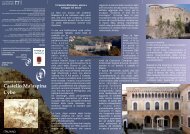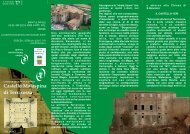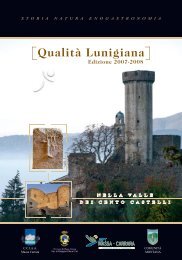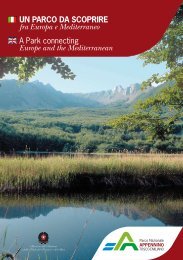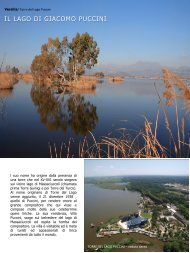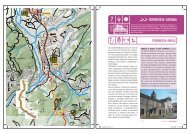Carrara the town of Quarries - CVB Versilia Costa Apuana
Carrara the town of Quarries - CVB Versilia Costa Apuana
Carrara the town of Quarries - CVB Versilia Costa Apuana
You also want an ePaper? Increase the reach of your titles
YUMPU automatically turns print PDFs into web optimized ePapers that Google loves.
THE WHITE MARBLE QUARRIES - CARRARA<br />
Fantiscritti marble basin, <strong>the</strong> Vara Bridges<br />
The visit to <strong>the</strong> three marble quarries <strong>of</strong><br />
torano, Fantiscritti and Colonnata i a<br />
unique and unforgettable experience.<br />
Along <strong>the</strong> route <strong>of</strong> <strong>the</strong> former Rilway line<br />
visitros can take a spectacular trip,<br />
driving on <strong>the</strong> bridges called Ponti di<br />
Vara and under <strong>the</strong> fascinating tunnerls<br />
dug into <strong>the</strong> rock, towards <strong>the</strong> discovery<br />
<strong>of</strong> those quarries expoloited even before<br />
<strong>the</strong> Romans for <strong>the</strong> white marble that is<br />
famous all over <strong>the</strong> world. From <strong>the</strong><br />
imperial perios till <strong>the</strong> Sixties, when <strong>the</strong><br />
first roads <strong>of</strong> communication were built,<br />
<strong>the</strong> blocks <strong>of</strong> marble were carried<br />
downhill with <strong>the</strong> dangerous method <strong>of</strong><br />
“lizzatura”: over carts dragged by oxen<br />
along <strong>the</strong> Via Carraia <strong>the</strong> marble reached<br />
<strong>the</strong> harbour <strong>of</strong> Luni.<br />
The quarrying techniques in use up to<br />
<strong>the</strong> 18° century had not changed since<br />
<strong>the</strong> Roman age. A relevant change was<br />
registered only with <strong>the</strong> introduction <strong>of</strong><br />
explosive and black powder and, later<br />
on, <strong>of</strong> <strong>the</strong> helical thread and <strong>the</strong><br />
diamond cutting chains. The large<br />
number <strong>of</strong> hand-made marblel pieces,<br />
inscriptions on marble and findings<br />
discovered in <strong>the</strong> quarries are on display<br />
at <strong>the</strong> Civica Marble Museum. If you<br />
want to visit <strong>the</strong> three marble fields and<br />
admire <strong>the</strong> famous white marble quarries<br />
at close quarters, you can ask for<br />
personalized tours.<br />
WHITE MARBLE QUARRIES<br />
MICHELANGELO QUARRY
CAVA RAVACCIONE<br />
On <strong>Carrara</strong>’s mountains rise in a ring <strong>the</strong><br />
small <strong>town</strong>s <strong>of</strong> <strong>the</strong> quarry-workers, which<br />
have always been linked with <strong>the</strong> activity<br />
<strong>of</strong> processing <strong>the</strong> marble extracted form<br />
<strong>the</strong> Apuan Alps. CODENA, BERGIOLA,<br />
BEDIZZANO, COLONNATA, MISEGLIA,<br />
TORANO and, located on <strong>the</strong> state road<br />
n.446 towards <strong>the</strong> Apuan Park,<br />
SORGNANO, GRAGNANA, NOCETO, and<br />
<strong>the</strong> old hamlet <strong>of</strong> CASTELPOGGIO<br />
The Ravaccione Quarry. You can live<br />
<strong>the</strong> experience to walk in a moon<br />
landscape, known as <strong>the</strong> Marble<br />
Ca<strong>the</strong>dral. The Ravaccione Quarry is an<br />
underground quarry, in <strong>the</strong> heart <strong>of</strong> a<br />
mountain. You take a small bus for <strong>the</strong><br />
first 600 mt, <strong>the</strong>n you will be lead through<br />
CAVA RAVACCIONE ART EXHIBITION<br />
<strong>the</strong> path, where you can see <strong>the</strong> equipments used and a guide will explain <strong>the</strong> steps for <strong>the</strong> marble processing.<br />
Cava 177. you can visit one <strong>of</strong> <strong>the</strong> most ancient white marble quarries and relive <strong>the</strong> history <strong>of</strong> this extraordinary<br />
stone. The quarry is on <strong>the</strong> road to Colonnata on <strong>the</strong> crossroad between Fantiscritti and Colonnata.
COLONNATA AND ITS QUARRIES…<br />
Colonnata (532 m above sea level ) is an ancient village, and a frazione in <strong>the</strong> comune <strong>of</strong> <strong>Carrara</strong>. It is situated in<br />
<strong>the</strong> Apuan Alps, and is known worldwide for <strong>the</strong> pork fat delicacy Lardo di Colonnata, and for its marble quarries.<br />
Colonnata is located in <strong>the</strong> Apuan Alps (mounts Maggiore, Spallone and Sagro), and is accessible by <strong>the</strong> road that<br />
passes through <strong>the</strong> villages <strong>of</strong> Vezzala and Bedizzano. The village is surrounded by quarries in an area known as<br />
"Gioia Calagio", which includes <strong>the</strong> Gioia Pit, which produces <strong>the</strong> arabescato and bardiglio varieties <strong>of</strong> veined marble.<br />
The quarry was also used in ancient times, as evidenced by <strong>the</strong> finds <strong>of</strong> coins, inscriptions engraved directly on <strong>the</strong><br />
rock, and a relief <strong>of</strong> <strong>the</strong> Roman tutelary deity Silvanus. The largest Roman quarrying site yet discovered was one<br />
kilometre south at Fossacava. Colonnata's history dates back to its settlement, around 40 BC. It was built for <strong>the</strong><br />
housing <strong>of</strong> slaves used in quarrying marble after Rome decided to replace expensive imported Greek marble with local<br />
(Luni) marble.The name <strong>of</strong> <strong>the</strong> settlement is believed derived from <strong>the</strong> Latin word columna, indicating <strong>the</strong> place<br />
where columns <strong>of</strong> marble were extracted to be sent to Rome, but <strong>the</strong> origin <strong>of</strong> <strong>the</strong> name could also be <strong>the</strong> Latin collis<br />
("hill") or columen ( "top"). The quarries may also have been used by <strong>the</strong> Ligurian Apuani tribe, who were perhaps<br />
also used later as quarrying experts. Evidence <strong>of</strong> mining activity dating back to <strong>the</strong> 6th century BC has been found at<br />
"Fossa Carbonera", Fantiscritti. Based on a stone found in 1810 bearing <strong>the</strong> names <strong>of</strong> <strong>the</strong> consuls <strong>of</strong> <strong>the</strong> years 16 - 22<br />
AD, it appears that <strong>the</strong> settlement was run by settlers and a magistrate, all <strong>of</strong> servile origin, who oversaw <strong>the</strong> work.<br />
Additional records date back only to <strong>the</strong> 13th century, while <strong>the</strong> church <strong>of</strong> <strong>the</strong> village is believed to date back to <strong>the</strong><br />
12th century. It's possible, however, that in <strong>the</strong> Middle Ages Colonnata was used as a defensive stronghold for those<br />
who controlled <strong>the</strong>se areas after <strong>the</strong> Roman Empire (<strong>the</strong> Byzantines, <strong>the</strong> Goths and Lombards).
The village is still mainly supported by<br />
mining. The breeding <strong>of</strong> pigs, promoted<br />
by <strong>the</strong> abundance <strong>of</strong> chestnut trees, was<br />
introduced to Colonnata, perhaps by <strong>the</strong><br />
Lombards. Over time, this industry<br />
evolved, in particular processing freshly<br />
slaughtered meat, which was used as<br />
bread spread by <strong>the</strong> quarrymen, thus<br />
starting <strong>the</strong> traditional production <strong>the</strong><br />
famous pork fat delicacy, Lardo di<br />
Colonnata..The village has maintained<br />
some <strong>of</strong> its historic features, such as <strong>the</strong><br />
use <strong>of</strong> marble in murals, doorways,<br />
doorjambs, windows and o<strong>the</strong>r<br />
architectural features. Also to be seen are<br />
<strong>the</strong> north gate into <strong>the</strong> <strong>town</strong>, which<br />
belonged to <strong>the</strong> medieval city walls now<br />
gone; a yard paved in marble located at<br />
<strong>the</strong> far south end <strong>of</strong> <strong>town</strong>;<br />
COLONNATA VILLAGE<br />
<strong>the</strong> Piazza Palestro, which leads to a modern<br />
sculpture dedicated to Cristo dei Cavatori<br />
("Christ <strong>of</strong> <strong>the</strong> Quarrymen");<br />
and <strong>the</strong> stone bell tower with a view and a<br />
clock.The sixteenth-century San Bartolomeo<br />
parish church has a marble interior, including a<br />
main altar in white marble, side altars in multicoloured<br />
marble, a marble relief depicting <strong>the</strong><br />
Assumption <strong>of</strong> Mary into heaven among <strong>the</strong><br />
saints, preserved fragments <strong>of</strong> an ancon from<br />
<strong>the</strong> altar <strong>of</strong> Saints Andrew, Bartholomew and<br />
Peter, and a 17th century marble crucifix<br />
attributed to a pupil <strong>of</strong> Michelangelo.<br />
COLONNATA: LARDERIE - LARD SHOPS<br />
COLONNATA: LARDERIE<br />
COLONNATA: QUARRIES
LARD OF COLONNATA<br />
The Lard <strong>of</strong> Colonnata is a typical pork product<br />
<strong>of</strong> <strong>Carrara</strong>. Unique for its particular salting and for its<br />
curing in marble tubes, <strong>the</strong> Lard <strong>of</strong> Colonnatata is<br />
a protected geographical identification(P.G.I.)<br />
product. It is taken from <strong>the</strong> layer <strong>of</strong> hard fat along <strong>the</strong><br />
pig's back and normally only Tuscan porks are used.<br />
This fine salami is made from pork lard which is cured in<br />
local <strong>Carrara</strong> marble. Layers <strong>of</strong> lard are alternated<br />
with herbs such as pepper, cinnamon, cloves,<br />
coriander, sage and rosemary. The marble used is<br />
rubbed also rubbed with garlic and <strong>the</strong> maturation<br />
time can last anything from 6 to 10 months. This<br />
delicious salami is still made in this traditional way<br />
which gives it its s<strong>of</strong>t consistency and sweet flavour,<br />
enriched by <strong>the</strong> herbs and spices used in <strong>the</strong><br />
preparation. It should be served just melting on hot<br />
pieces <strong>of</strong> toast. Lardo di Colonnata is now included in<br />
<strong>the</strong> Ark <strong>of</strong> Taste catalogue <strong>of</strong> heritage foods as<br />
well as enjoying IGP (Protected Geographical<br />
Indication) status.<br />
LARDO DI COLONNATA<br />
LARDO &<br />
LARDO NELLE CONCHE DI MARMO
PHOTOGALLERY
F<br />
E<br />
D<br />
C<br />
B<br />
A<br />
A<br />
B<br />
C<br />
D<br />
E<br />
F<br />
CARRARA<br />
COLONNATA<br />
COLONNATA QUARRIES<br />
FANTISCRITTI QUARRIES<br />
TORANO QUARRIES<br />
RAVACCIONE QUARRY<br />
Piazza Mazzini - Palazzo delle Muse -<br />
Viareggio - Tuscany - Italy<br />
Ph.+39 0584 48 881 fax.+39 0584 47 406<br />
www.versiliacostapuanaconvention.it<br />
e-mail cvb@aptversilia.it



